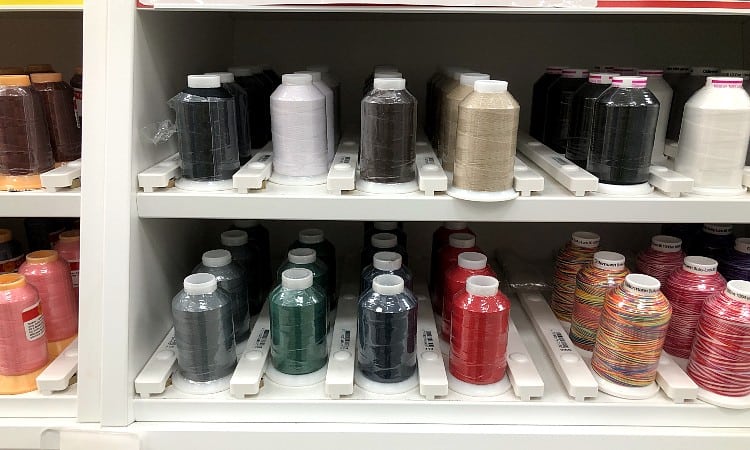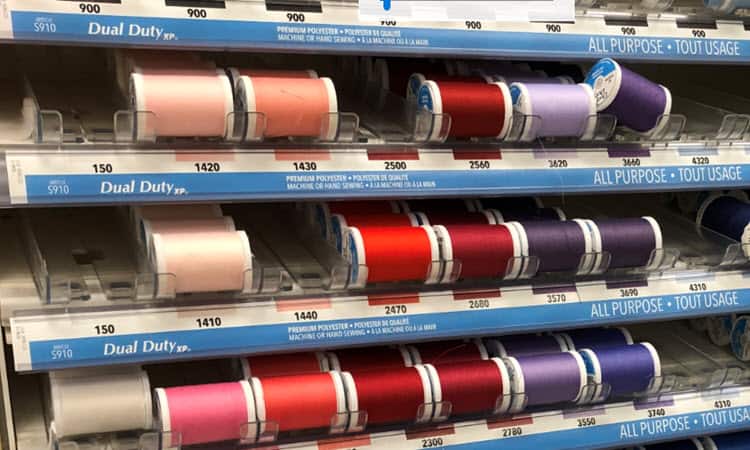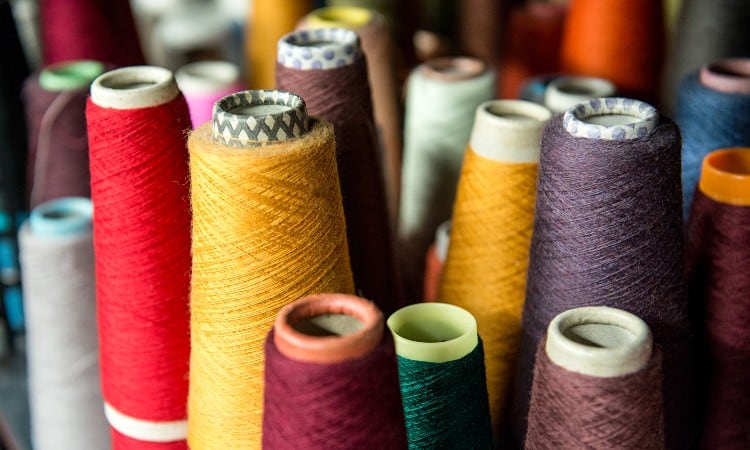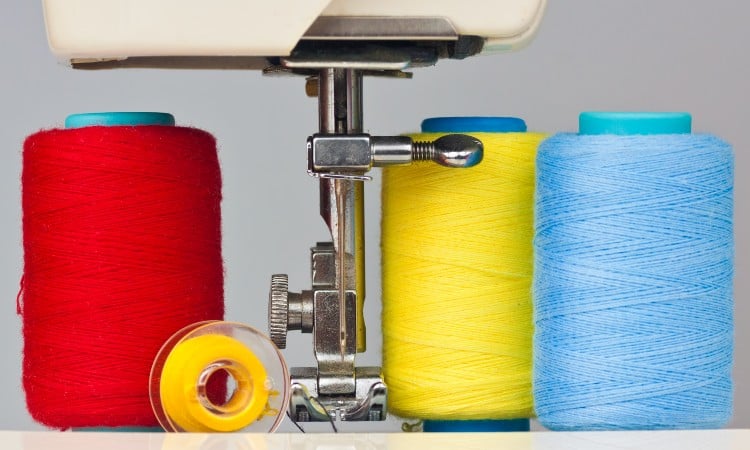Have you ever tried to thread a needle, but the thread just won’t go through the eye? Sewing thread comes in many different sizes, and picking the right one for your project will help you sew smoothly and easily! The key is to learn about sewing thread sizes so you can pick the correct size for your project.
Sewing thread uses four common size measurements: weight, denier, tex, and commercial sizes. In the US, the most common thread measurement is a weight system. All-purpose polyester thread in the US usually has a 40-wt size, while 30 and 50-wt thread remains popular.
In this article, you will find out what the size numbers on your thread mean. You will discover how to choose the right size of thread for your project. Finally, you will learn how different sizes of thread compare.

What Do Sewing Thread Size Numbers Mean?
Thread sewing size numbers help you understand the thickness and strength of the thread. The tricky thing is that thread can use four different kinds of size numbers, so you need to know what each type of measurement means before you pick your thread.
Before you get into the four different units of weight, tex, denier, and commercial thread sizing, you should note one crucial fact. Thread size does not tell you the size or diameter of the thread. Instead, it tells you the weight of a set amount of thread.
This is because thread squishes when scientists try to measure its diameters with teeny-tiny calipers. So, since it is impossible to accurately measure the diameter of the thread, you use the weight to describe its size instead.
Weight
In the United States, a lot of sewing thread uses a weight measurement to describe the size of the thread, especially all-purpose thread or the kind of thread you use in a regular sewing machine. If the number on your thread reads “50 wt,” it uses a weight measurement.
This gets a tad confusing, though, because some spools may just have a two-digit number and say simply “30,” “40,” or “50.” This two-digit code almost always means the thread uses the weight system to size it.
To find the weight of the thread, you measure how many kilometers of thread you need to reach a weight of one kilogram. So if it takes 50 kilometers of thread to add up to a weight of one kilogram, your thread is 50 wt. Likewise, if just 30 kilometers of thread weigh one kilogram, your thread is 30 wt.
This means that larger weight numbers indicate a finer, smaller, looser, less dense thread. Small numbers mean heavier, thicker, or more dense thread.
Most all-purpose polyester thread has a 40 wt size, while fine cotton thread for sewing on linen may have a size of 50 wt.
Another question you may wonder is, why does the most popular US unit of thread sizing use the metric system when everything else in the US uses US units like pounds? No one knows!
Finally, you will sometimes see an additional number following the size in weight on the thread, like this: 50/2 or 50-2. In this case, the extra number tells you how many strands the thread contains. Most sewing thread is either one or two-ply, meaning it contains a single or two strands twisted together.
The trouble with this system is the plies, or strands, twisted together to comprise the thread. The US borrowed this sizing system from a complex system called the Gunze system, originally used in Japan. The Gunze system lists the weight of the thread followed by a slash and then the py of the thread.
This means that a thread with 40 wt and 2 ply will have a smaller diameter than a thread with a 40 wt but three ply. But the thread will still have the same size printed on it!
Tex
The tex rating of thread tells you how many grams 1,000 meters of thread weighs. For example, If 50 meters of thread weighs one gram, the thread will have a rating of Tex 50.
This metric system is simple and is commonly used in Europe and other parts of the world.
This system makes a lot more sense than the weight system used in the US because, in a Tex rating, larger numbers indicate a thicker, heavier, or dense thread.
Fine, lightweight Tex ratings range from Tex 9 to 19, while all-purpose or midweight ratings include Tex 20 to about 70 and heavier, thicker ratings reach from Tex 70 on up.
Denier
The denier unit of measurement tells you how much 9000 meters of thread weighs. If 9,000 meters of thread weighs 50 grams, then the thread will have a marking of Den 50. If the 9,000 meters of thread weighs 80 grams, the marking will read Den 80.
Like with the Tex unit, larger numbers indicate a thicker or heavier thread in the Denier unit of measurement.
You see the denier unit of measurement used most often to describe the size of embroidery thread or fine threads today. It is also used with silk to describe the thinness or thickness of individual threads within the silk fabric. The reason we still use Denier as a measurement today is that women used this unit of measurement to buy silk thread in the same size as the threads in their silk stockings for easy darning!
As a fun fact for you, the name “denier” is derived from an ancient Roman coin called a denarius, probably because of the costly nature of silk.
Commercial
Finally, the commercial thread takes a different approach by using a measurement system that divides the denier of a type of thread by 10. For example, if the thread has a denier of 300, it will have a commercial size of 30.
Commercial thread comes in a few set sizes, so you can always expect to see the same numbers on this type of thread. These sizes are 30, 46, 69, 92, 138, 207, 277, 346, 415 and 554.
Commercial thread usually has extra strength and thickness, such as the type of thread you would use to sew jeans or upholstery. Some commercial thread looks extremely thick and is used for things like sewing sails for boats.
How Do I Know What Weight My Thread Is?

The best way to find out the weight of a type of thread is to look for the number stamped onto the spool or on the outside of the cardboard tube inside a cone of thread. If you order your thread online, you can also find this information in the product description.
Use these tips to help you interpret the thread sizing numbers:
- Look for a three-letter abbreviation to help you determine what unit of measurement the thread uses. WT means weight, Tex means tex, and Den means denier.
- If the number has a slash and then a single-digit number, or a space and then a single number, the second number tells you the ply of the thread. So Den 30/2 means thread with a denier of 30 and two strands twisted together.
- Anytime you see a heavy-duty thread with a three-digit sizing number, it almost certainly uses a commercial unit of measurement.
How Do I Know What Thread Size I Need?

You can find out what thread size you need by reading the instructions on a sewing pattern, assessing the weight and type of fabric you will use, or selecting the thread size for the type of sewing you will do, such as embroidery vs overlocking.
Most sewing patterns will tell you what type and size of thread to use in the notions section of the instructions. You can find this information either on the back of the paper envelope or in the fabric selection section in most digital patterns.
You should also consider the weight and type of fabric you plan to use when picking a thread size. It sounds simple, but lightweight fabric pairs best with fine, lightweight thread. Using a large thread will leave big holes in the material that will show! Likewise, if you use a fragile, lightweight thread with a thick fabric such as denim, the heavier fabric will pull on the thread and may eventually cause the stitching to fray or snap.
Finally, you can also follow some general guidelines to know what thread size often works best for what type of sewing.
- Thread with a fine or lightweight size range works best for detailed work like monogramming on an embroidery machine or using a monofilament thread to stitch patterns into the surface of a quilt. You also use fine thread for various specific sewing purposes, such as sewing invisible hems.
- Threads in a medium size range work best for all-purpose sewing, quilting, sergers and overlock machines, and even most embroidery machines. This is by far the most popular size of thread and the one that will work best with most sewing projects!
- Threads in a large size range, more often called heavyweight thread, have several specialty purposes. You can use this thread for upholstery, sewing on thick fabric like canvas and denim, or topstitching.
As a pro tip, make sure you pick the right size of needle to go with the size of your thread. Also, you commonly need to adjust the tension on your sewing machine every time you use a different size of thread.
What Does 3/4 Inch Thread Mean?
A 3/4 inch thread refers to metal pipes, not to sewing thread! This measurement tells you how many threads, or raised grooves, circle the end of the pipe per square inch. This helps plumbers connect fittings and elbows and other types of pipes together.
What Does 40/2 Thread Mean?
 A 40/2 thread can mean thread with a Denier of 40 and a 2-ply structure, thread with a Tex of 40 and 2 ply, or thread with a 40 wt and 2 ply.
A 40/2 thread can mean thread with a Denier of 40 and a 2-ply structure, thread with a Tex of 40 and 2 ply, or thread with a 40 wt and 2 ply.
The thread size should tell you what unit of measurement was used to find the size. This is the only way to determine whether you have an industrial-grade super heavy-duty thread or an average spool of all-purpose thread in 40 wt.
If the thread reads “40 wt 2” it is a standard spool of all-purpose thread.
Sewing Thread Thickness Chart
This chart gives you a quick overview of the sizes of thread commonly used for certain types of sewing.
| Weight | Tex | Denier | Used For | |
| Light | 60 – 50 | 16 – 20 | 150 – 180 | Bobbin and specialty |
| Midweight | 40 | 25 | 225 | All-purpose, garments, quilting |
| Heavy Duty | 30 – 20 | 33 – 50 | 300 – 450 | Upholstery, home decor, jeans |
Thread Weight to Tex Conversion
You can easily convert a thread size from a weight unit to a Tex unit by dividing 1,000 by the size in weight. For example, if your thread has a size of 40 weight, divide 1,000 by 40 to find a Tex size of 25.
You could also measure 1,000 meters of thread and see how many grams it weighs, but the simple equation listed above will take much less time!
You can also divide 9,000 by the size in weight to find the denier of a spool of thread that only liss the size in a unit of weight.
Thread Weights Compared
Once you understand how each thread sizing system works, you can easily find out how thread weights compare.
Which Thread is Thicker, 40 or 60?
 Whether a thread with a size of 40 or 60 is thicker depends on the unit of measurement used to determine the size.
Whether a thread with a size of 40 or 60 is thicker depends on the unit of measurement used to determine the size.
If you use the thread weight system, 40 wt will have a thicker diameter, a denser structure, and a heavier weight than a thread with a 60 wt size. But if you use the Tex system, a thread with a size of 40 will weigh less and have a smaller diameter than a thread with a size of 60.
That said, the numbers 40 and 60 usually do mean a thread size using the weight system. In this case, 40 wt indicates a midweight, all-purpose sewing thread size, while 60 wt indicates a very fine and thin thread. You can use 40-wt thread for most sewing projects, like sewing a blouse or a doll dress, but you should reserve 60-wt thread for specialty projects like invisible hems.
Which Thread is Thicker 30 or 50?
 Again, determining whether a size 30 thread or a size 50 thread is thicker depends on the system of measurement used.
Again, determining whether a size 30 thread or a size 50 thread is thicker depends on the system of measurement used.
When using the weight system, a 30-wt thread is heavy-duty and suitable for sewing upholstery or denim jeans, while a 50-wt thread is much finer and thinner.
On the other hand, thread with a size of Tex 50 is incredibly heavy weight, possibly even commercial or industrial grade!
Which is Heavier, 30 or 40 Thread?
 Whether size 30 or size 40 thread is heavier depends on the unit of measurement used to determine the thread size. In the US, the most common unit of measurement for thread size is the weight system. In this system, larger numbers indicate lighter, finer thread, while smaller numbers mean thicker, heavier thread.
Whether size 30 or size 40 thread is heavier depends on the unit of measurement used to determine the thread size. In the US, the most common unit of measurement for thread size is the weight system. In this system, larger numbers indicate lighter, finer thread, while smaller numbers mean thicker, heavier thread.
In this case, 30 wt thread will have a heavier weight than 40 wt thread. You can use 40-wt thread for sewing projects like quilting, embroidery, dressmaking, or hemming. On the other hand, the 30-wt thread feels much thicker and heavier, and you use this heavy-duty thread for sewing projects like upholstery or hemming velvet curtains.
What is the Difference Between 400 and 200 Thread?
The difference between 400 and 200 thread can describe either the denier of the thread or the thread count of a piece of fabric like a bed sheet. The difference between 400 denier thread and 200 denier thread is that the 400 denier thread will look much thicker and feel twice as heavy as the 200 denier thread.
For example, you might use 200 denier thread to sew a dress, a quilt, or a tablecloth. But you would reserve 400 denier thread for upholstering an armchair, topstitching a thick canvas bag, or stitching the edge of a heavy banner.
The other instance where you see 200 and 400 threads compared is when you look at thread count. This does not exactly describe the size of the threads in the fabric. Instead, it tells you how many threads fit inside one square inch of the fabric.
So a 200 thread count means that the fabric has 200 threads inside one square inch, and a 400 thread count describes fabric with 400 threads packed into every square inch. A higher thread count typically indicates a softer, finer fabric.
What Size of Thread is Best for a Sewing Machine?

The best size of thread for a sewing machine depends on what kind of sewing you plan to do, as you will want to use varying sizes of thread for projects such as topstitching, sewing a seam, or appliqueing. That said, nine times out of ten, a 40-wt all-purpose thread will work for most projects you sew on a sewing machine.
Most domestic sewing machines can use thread up to a size of 14 wt or Tex 70. Beyond that, the thread requires such a big needle that the machine can’t easily push the needle through the fabric.
Another way to pick the best type of thread for a sewing machine is to start with the type of sewing machine needle you plan to use and match that to the size of the thread that suits the needle.
Sewing machine needles often list two numbers, separated by a slash, like this:80/12. The bigger number uses the European size system, which describes the diameter of the needle in millimeters. The American sizing system, predictably, does not make so much sense. But you will always know that a smaller number means a thinner, finer needle, while a larger size means a thicker, heavier needle.
Generally speaking, you can match thread size and needle size like this:
- 60/8 and 70/10 needles have a fine, slender shaft and a small eye, suitable for working with spiderweb thin, 100 wt superfine or invisible threads. You may also use these needles with some embroidery machines for detailed work like monograms.
- 80/12 needles work well with 50 wt thread, which you may use on many sergers and for sewing projects like appliqueing, sewing doll clothes or miniatures, or doing fine piecework for garments.
- 80/12 needles (also known as universal needles, the most popular needle size for a sewing machine) also work just fine with all-purpose 40-wt thread. You use this needle and thread combo for sewing projects like quilting and clothing.
- For some projects, you can use a slightly heavier 90/14 needle with 40-wt thread. This works well with midweight fabric, while the 80/12 needle works well with light and midweight fabrics.
- 100/16 needles work well with 30 wt and thicker threads. Not every sewing machine does well with this large needle and heavy thread, so read your sewing machine manual before you try using this heavy-duty needle and thread pairing.
Some needles also list a special description beside the size, such as ballpoint or topstitch needles. These needles may have larger or smaller eyes to pair with the special size of thread used in certain types of sewing.
Finally, you may also want to consider aesthetics when you pick a thread size. Light weight that shows up less than heavier weight thread on any sewing project. If you want the stitches to show, use a heavier thread! This is why a topstitching thread is a heavier weight than an all-purpose thread and why a topstitching needle has a larger eye to accommodate the thread.
Conclusion
Thread sizes use four different popular units of measurement to describe the weight and thickness of the thread. In the United States, the thread weight system describes how many kilometers of thread weighs one kilogram. The tex system tells you how many grams 1000 meters of thread weigh, the denier system tells you how many grams 9,000 meters of thread weigh, and the commercial thread sizing method divides the denier of the thread by 10.
To pick the right size of thread for your project, you can match the thread size to the weight of your fabric. You can also match the thread size to the needle size or read the instructions in your sewing pattern. A larger thread will look more visible in your finished project, while a lightweight thread will blend into the fabric.
Have you ever bought sewing thread based on its size? How did you decide what size of thread worked best for you? Leave a comment below to let us know!